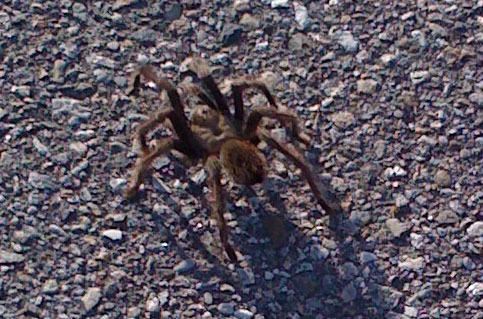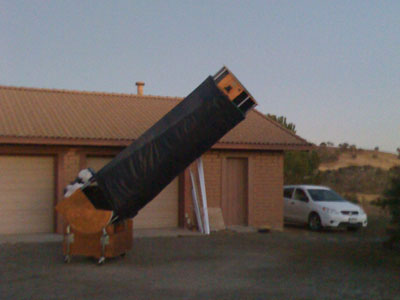Mark Johnston, Peter Krottje and I met at the overflow parking lot at Henry Coe state park last night. I brought my Meade Lightbridge 12″ (after flocking the inside of the UTA with black velvet ordered from Edmund Optics), while Mark brought both his 18″ Starmaster dobsonian as well as a newly acquired equatorially mounted 190mm Orion Mak-Newt. Peter was using his homemade 10″ ultra light dobsonian.
The sky grew darker as the evening went on thanks to the fog dimming the lights emanating from San Jose, Morgan Hill and Gilroy. By 11pm, we were getting SQM readings of almost 21.2, which is pretty good for Henry Coe. The transparency however was clearly below average, and the low level haze was causing some obvious dimming up to 15 degrees of elevation, especially to the south and the west. The sky was however more than decent between the north east and the south east, which is where I spent most of the night, observing mostly open clusters in Andromeda, Lacerta and Cassiopeia.
Here’s a summary of the weather conditions:
- Average seeing.
- Mild (but annoying) westerly wind.
- Surprisingly cold (I had to really bundle up, and almost needed gloves by 11pm)
Here are some of the highlights of the evening:
- 18 open clusters from the Herschel 400 list. Most of them were honestly not very interesting, except maybe the ET cluster, and a couple of clusters in Cassiopeia that happened to fit within the same FOV of my Pan 27, showing some differences in structure.
- We observed the California nebula with my 50mm finder scope using a 16mm Nagler type 5 and a UHC filter. We got a much better view through Mark’s 190mm Orion Mak-Newt using a wide field eyepiece and an H-beta filter.
- We saw the fourth flea around NGC 7331 through Mark’s 18″ scope, and I later caught a glimpse of it in my 12″ scope, although it was coming in and out of view (knowing where to look really helps!)
- The GRS was transiting. A darker slightly elongated region was spotted right next to it. Probably some disturbance in the equatorial band.
- There was a nice shadow transit by Io on Jupiter.
It was my first night using the Orion self-centering adapter (instead of a standard 1 1/4″ adapter with a tightening ring) and I have to say that I really liked it! I’m sure it will be very handy this winter when switching eyepieces while wearing gloves.
I took off around midnight, and was soundly asleep by 1am. Overall, it was a good night, and I’m glad I went out. I’m looking forward to observing under darker skies next weekend to start on the Herschel II list, since I’m running out of Herschel I objects. Below is my log for the night. Cheers!
Location: Henry Coe state park [Elevation 2600 ft]
Telescope: Meade Lightbridge 12″ F/5
Eyepieces used:
- Televue Panoptic 27mm (56x – 1.2° TFOV)
- Televue Nagler 16mm type 5 (95x – 52′ TFOV)
- Televue Nagler 9mm type 6 (169x – 29′ TFOV)
- Televue Nagler 7mm type 6 (217x – 22′ TFOV)
- Televue Nagler 5mm type 6 (305x – 16′ TFOV)
(All times are PDT)
NGC 7296 OC Lac 22h28m27.3s +52°22’19″ 9.7 mag 08:00pm
About 30 stars, a dozen of which are fairly bright, grouped within an area roughly 4′ in diameter. Relatively inconspicuous, best seen at 217x.
NGC 7243 OC Lac 22h15m32.9s +49°57’09″ 6.7 mag 08:05pm
About 80 stars, 20 of which are pretty bright, within an area 25′ x 15′ elongated NE-SW. The center region, delimited to the west by a nice double star, is very sparsely populated.
NGC 7209 OC Lac 22h05m32.1s +46°32’11″ 7.8 mag 08:10pm
About 80 stars, 40 of which are uniformly pretty bright, within an area 20′ x 15′ elongated NNE-SSW. Moderately bright and slightly orange star near the center. Bright yellow star (HT Lac, mag 6.2) about 15′ N.
NGC 7686 OC And 23h30m37.3s +49°11’31″ 5.6 mag 08:15pm
About 30 moderately faint to moderately bright stars grouped within an area 15′ in diameter centered on a bright yellow-orange star (HD 221246, mag 6.2)
NGC 7789 OC Cas 23h57m56.4s +56°46’02″ 7.5 mag 08:50pm
Very rich and fairly compact. Very large number of moderately faint stars of comparable brightness scattered pretty uniformly within a roughly circular area 15′ in diameter.
NGC 7790 OC Cas 23h58m56.7s +61°16’01″ 7.2 mag 09:00pm
About 20 moderately faint stars within an area roughly 5′ x 3′ elongated E-W. The proximity of numerous star clusters in the vicinity (esp. NGC 7788) makes this cluster interesting to track down.
NGC 129 OC Cas 00h30m36.0s +60°16’34″ 9.8 mag 09:10pm
Located 15′ NNW of a bright star (HD 2626, mag 5.9) This cluster contains a good number of moderately bright to fairly bright stars. It is not very well delimited, especially to the north, making star counts unreliable. A few fairly bright stars form a ring elongated 3:2 NW-SE.
NGC 136 OC Cas 00h32m07.4s +61°34’04″ mag 09:20pm
Maybe a dozen faint stars grouped within an area 1.5′ in diameter. About 6′ NE of a fairly bright yellowish star (SAO 11238, mag 8.4) This cluster is so inconspicuous that a good atlas is a must to confirm that you’re indeed looking at the right spot.
NGC 381 OC Cas 01h08m59.4s +61°38’19″ 9.3 mag 09:30pm
Fairly sparse cluster containing about 30 moderately faint to moderately bright stars within an area roughly 6′ in diameter. Best seen at 169x.
NGC 225 (Sailboat Cluster) OC Cas 00h44m16.8s +61°49’55″ 8.9 mag 09:35pm
About 30 bright stars within an area 12′ x 8′ elongated NE-SW. Requires some imagination to see the outline of a sailboat…
NGC 457 (ET Cluster) OC Cas 01h20m15.4s +58°20’27″ 5.1 mag 09:40pm
Two bright stars (mag 5 and 7, the one to the NE being the brighter), located at the western end of the cluster, about 3′ apart, form the eyes of the ET cluster. A narrow group of stars, elongated NW-SE, form the body, and a few more bright stars form the arms.
NGC 559 OC Cas 01h30m14.5s +63°21’35″ 7.4 mag 10:25pm
About 30 fairly faint stars within an area roughly 5′ in diameter. Best seen at 169x.
NGC 436 OC Cas 01h16m38.2s +58°51’58″ 9.3 mag 10:25pm
Fairly compact cluster containing about 25 moderately bright to moderately faint stars within an area 5′ in diameter. Best seen at 169x.
NGC 637 OC Cas 01h43m49.4s +64°05’29″ 7.3 mag 10:35pm
Small, compact group of about 20 stars, 5 of which are fairly bright, the others are fairly faint, within an area roughly 3′ in diameter elongated NE-SW. Best seen at 217x.
NGC 654 OC Cas 01h44m44.2s +61°56’11″ 8.2 mag 10:40pm
About 40 moderately faint stars within 5′. Best seen at 169x. Located 3′ NNW of a bright yellow-orange star (HD 10494, mag 7.3) Fits with NGC 663 in the same field of view of my Panoptic 27mm eyepiece, showing some nice difference in structure.
NGC 663 OC Cas 01h46m53.1s +61°17’10″ 6.4 mag 10:40pm
About 80 fairly bright stars within an area 15′ x 10′ elongated NW-SE. Fits with NGC 654 in the same field of view of my Panoptic 27mm eyepiece, showing some nice difference in structure.
NGC 659 OC Cas 01h45m07.6s +60°43’29″ 7.2 mag 10:45pm
About 15 moderately faint stars within an area 4′ in diameter. Best seen at 169x. Located about 15′ NE of a trio of bright stars.
NGC 752 OC And 01h58m18.5s +37°50’08″ 6.6 mag 10:50pm
Seen with the naked eye as a fuzzy spot between Tri and And. Best seen using the 50mm finder scope using a 16mm Nagler type 5 eyepiece. In my 12″ scope, using a Panoptic 27mm eyepiece, more than 100 bright stars are visible. Two bright yellowish stars were seen near the south-western boundary (56 And and HD 11727, mag 5.7 and 5.9 respectively)

